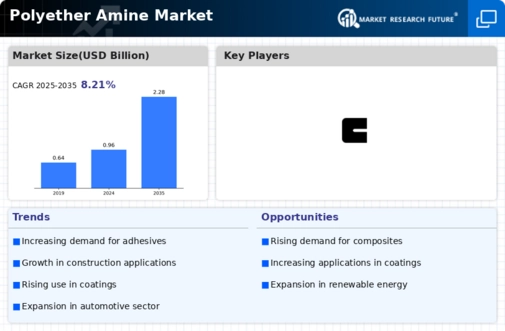Top Industry Leaders in the Polyether Amine Market

Polyether amines (PEA) are versatile organic compounds finding increasing prominence in various industries. Boasting exceptional properties like low viscosity, high reactivity, and excellent miscibility, these amines act as crucial curing agents for epoxy resins, leading to their surging demand in sectors like construction, wind energy, and electronics. However, navigating this competitive landscape requires strategic prowess and adaptability.
Key Strategies Dominating the Market:
-
Product Diversification: Leading players like Huntsman International LLC, BASF SE, and Clariant are expanding their PEA portfolios, introducing formulations tailored to specific applications. This differentiation caters to diverse customer needs and strengthens market share. -
Vertical Integration: Securing upstream control over key raw materials like polyetherols is crucial for maintaining stable supply chains and cost competitiveness. Companies like Dasteck Chemicals are pursuing this strategy, gaining control over critical resources. -
Technological Advancements: Research and development in novel PEA production methods and improved compatibility with various epoxy resins are vital for sustained growth. Solvay's recent development of low-odor PEA for coatings exemplifies this innovative approach. -
Geographic Expansion: Emerging economies like China and India present immense potential for PEA consumption. Companies like Chai-Tai New Materials are strategically building production facilities in these regions to capitalize on the growing demand. -
Sustainability Focus: Environmental concerns surrounding volatile organic compounds (VOCs) are mendorong manufacturers to develop low-VOC or bio-based PEA alternatives. Wacker Chemie's initiatives in producing eco-friendly PEAs demonstrate this commitment to sustainability.
Factors Dictating Market Share:
-
Brand Reputation and Reliability: Established players with proven track records like AkzoNobel and Dow Chemical enjoy significant market share due to their brand recognition and consistent quality. However, innovative startups addressing niche applications can still carve out their space. -
Cost Competitiveness: Optimizing production processes and sourcing affordable raw materials are crucial for cost leadership. Asian manufacturers often have an edge due to lower labor costs, but premium brands command higher prices due to superior performance and reliability. -
Distribution Network and Customer Service: Extensive distribution networks and prompt technical support are essential for customer satisfaction and repeat business. Companies like Huntsman International LLC excel in this area. -
Regulatory Landscape: Stringent environmental regulations, especially in Europe and North America, are pushing manufacturers towards low-VOC and bio-based PEA alternatives. Adapting to evolving regulations and developing compliant products becomes crucial for market success.
Key Players:
Clariant (Switzerland), Huntsman International LLC (US), ZIBO DEXIN LIANBANG CHEMICAL INDUSTRY CO., LTD (China), Yangzhou Chenhua New Material Co., Ltd (China), Yantai Dasteck Chemicals Co., Ltd (China), BASF SE (Germany), Qingdao IRO Surfactant Co., Ltd, and WUXI ACRYL TECHNOLOGY CO., LTD (China) and others,
Industry News and Recent Developments:
August 2023: BASF SE partners with a leading wind turbine manufacturer to develop custom PEA formulations for improved blade durability and performance.
October 2023: The Chinese government announces plans to invest in infrastructure projects using epoxy composites, boosting demand for PEA in the construction sector.
November 2023: The European Union proposes stricter VOC emission regulations for coatings, posing a challenge for conventional PEA manufacturers but pushing development of low-VOC alternatives.
December 2023: Dasteck Chemicals successfully scales up its production capacity for a novel high-performance PEA, targeting demanding applications in electronics and aerospace.

